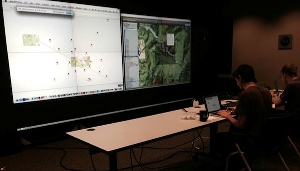Jul 18 2014
A small army of 75 geophysicists is set to converge on Mount St. Helens this weekend to begin final preparations for the equivalent of a combined ultrasound and CAT scan of the famous volcano’s internal plumbing.
The ambitious project, a joint undertaking by Earth scientists at Rice University, the University of Washington, the University of Texas at El Paso and other institutions, requires placing more than 3,500 active seismological sensors and 23 seismic charges around the volcano over the next few days.
 The planning for iMUSH's network or sensors began at Rice's Chevron Visualization Laboratory, where scientists used a variety of spatial information databases to plan the best locations for shot points and receiver lines.
The planning for iMUSH's network or sensors began at Rice's Chevron Visualization Laboratory, where scientists used a variety of spatial information databases to plan the best locations for shot points and receiver lines.
“Mount St. Helens and other volcanoes in the Cascade Range threaten urban centers from Vancouver to Portland, and we’d like to better understand their inner workings in order to better predict when they may erupt and how severe those eruptions are likely to be,” said Rice’s Alan Levander, the lead scientist for the experiment.
Levander, Rice’s Carey Croneis Professor of Earth Science, said the instruments will measure seismic waves generated by the detonation of charges in 23 boreholes that are each about 80 feet deep. Most of the detonations are scheduled in the evening on July 22-23, but Levander said area residents are unlikely to hear or feel them because of the depth of the boreholes and because the detonations will produce vibrations that approximate a magnitude 2 earthquake, which typically cannot be felt.
“Our shots will provide enough seismic energy to develop a clear picture of the mountain’s inner workings, but in most cases not enough to be felt and certainly no more than low-level seismic activity that occurs in the area on a weekly basis,” Levander said.
Levander said the detonations will take place in areas where the ground has already been disturbed, such as clear-cuts, quarries, gravel pits and garbage dumps.
Dozens of mostly student volunteers are expected to arrive Friday for two days of training about how to set up the 3,500 active seismic sensors that will gather the bulk of the experimental data.
“These sensors are basically a computer in a can with a small battery,” Levander said. “They’re about the size of a water bottle, but because of their limited power supply, we only have about two days to deploy the whole lot.”
He said the volunteers will also pick up all the active sensors — and the data they’ve collected — within a couple of days of the explosions.
A few more detonations will occur on the evening of July 30. A rearrangement of part of the sensor network will accompany those tests.
The coming tests follow two years of detailed planning and are part of a four-year project called Imaging Magma Under St. Helens (iMUSH), which could bring improvements in volcanic monitoring and advance warning systems at Mount St. Helens and other volcanoes.
The work area for the tests extends from Mount Rainier on the north to the Columbia River on the south, and from Interstate 5 on the west to Mount Adams on the east. An advanced team of researchers has been in the area for weeks installing 70 passive seismographs. Levander said these instruments, which take several hours to set up and will be left in place for two years, are more sophisticated and sensitive than the active sensors.
“The active-source monitoring will provide very high-resolution images at a relatively shallow depth, while the passive experiment data will be at a lower resolution but will be at a much greater depth,” said Kenneth Creager, a University of Washington professor of Earth and space sciences who is leading the passive monitoring.
Having both sets of monitors recording data from the active-source detonations will help scientists have a much clearer idea of how the deeper, harder-to-see structure compares with better defined shallow structure, he said.
A third technique, magnetotelluric monitoring, which produces data based on fluctuations in Earth’s electromagnetic field, will also be used to image the subterranean structures.
Mount St. Helens was chosen for the study because it has been the most active volcano in the Cascade Range, erupting twice in the last 35 years, and is readily accessible for the researchers and their equipment, Levander said.
The National Science Foundation funded the research. Levander is principal investigator on the active source component of the project. He said the team hopes to publish their findings in 2015. Other institutions involved include Oregon State University, the Lamont-Doherty Earth Observatory, Eidgenössische Technische Hochschule of Zurich and the United States Geological Survey.